Aug 19, 2020, Updated May 09, 2022 Kidney beans are cooked with onion, tomatoes and spices in this flavorful vegetarian curry.
Rajma is one of the most popular curries in north India. In fact I always say that chole, rajma and dal makhani are like the 3 most popular north Indian main course vegetarian recipes. Whenever we would invite someone over for lunch or dinner, mom would definitely make one of these. It was inevitable. However I was not very fond of rajma growing up, I don’t know why but I preferred it much less compared to the dals and chole and all my veggies. Sarvesh on the other hand is a huge rajma fan. It’s probably one of his favorite dishes (that’s a typical Punjabi right there)! But my taste buds have changed over the years and now I really enjoy rajma, especially the one I make. I do not like rajma if the curry is on the thinner side. For me a good rajma should be flavorful with the beans blending in with the spices and the curry should slightly be on the thicker side and have a melt-in-mouth texture.
What is Rajma
Rajma is kidney beans curry which is made by pressure cooking raw kidney beans which are soaked overnight. The pressure cooked beans are then cooked with onion, tomatoes, ginger-garlic and with spices like coriander, garam masala, chili powder etc. It’s an extremely popular curry in North India and a true Punjabi meal if often incomplete without it. Rajma is traditionally vegan (except when you add ghee to it) and also gluten-free. It is also a protein rich curry.
Which Kidney Beans To Use
Now when you go to market, you will see variety of kidney beans. There are lighter ones and also dark kidney beans. There are also varieties which are smaller in size. The smaller kidney beans are used in Kashmiri Rajma, which is a different recipe and uses different spices and you can find the recipe in my cookbook. You can use either one of the light or dark color large kidney beans to make punjabi style rajma. I prefer the darker ones.
Tips To Make a Good Rajma
So, I am going to share some of my tips that I have learned over the years to make a good rajma. Start with raw beans: yes you can make it with canned beans but a good rajma needs to be made with raw kidney beans. The beans need to be soaked overnight and then pressure cooked for that soft texture which is a must for rajma. I am sure most people who grew up around Delhi, would swear by the melt-in-mouth texture of rajma chawal (rajma and rice) being served at several food stalls across the city. And for that texture, you need to soak the beans, there are no two ways about it. Grate the onions or finely chop them: for that smooth curry, either grate the onions or really finely chop them. Also when you use grated onions, it takes a little longer for them to cook for the raw smell to go away, so have patience while cooking them. Use fresh ginger-garlic paste: again it will make a difference to the final taste of the rajma. Cook tomatoes for a longer time: do not rush this step. After you add the tomato puree, cook the tomatoes in total for around 15 minutes on medium heat before adding the kidney beans to the pan. I know that might seem like a long time but it’s important. Simmer on low heat: so after you add the boiled kidney beans to the pan, lower the heat and let the curry simmer for 20 minutes, at the very minimum. If you have time, add an additional 10 minutes. This simmering on low heat helps in developing the flavors and the curry tastes so much better. Mash some of the rajma to thicken the curry: while the rajma is simmering, take a spoon (or potato masher) and mash some of the kidney beans (not all) with the back of your spoon. This thickens the curry, gives it a texture and makes it creamier. Touch of ghee at end: I love adding a tablespoon of ghee at the end to my rajma. It really brings the flavors together. Sometimes, I would add fry some ginger julienne in the ghee and add to the rajma. Tastes even better the next day: curries like rajma and chole taste even better the next day. The beans absorb the flavors so well overnight and so the taste increases the next day.
Using Canned Beans
You can use canned beans here too. Use around 2.5 cans (around 3.5 to 4 cups of cooked beans) for this recipe. If using canned beans, skip the step of pressure cooking the beans. Start with making the masala, and then add the beans directly to the pan and then cook as mentioned in the recipe.
Serving Suggestions
In Delhi, rajma is always eaten with rice, popularly known as “rajma-chawal”. In fact if you ask people who are from Delhi (like my husband), half of them will say that rajma-chawal is their favorite dish. So obviously there cannot be a better combination than plain white rice. But you can also serve it with quinoa or brown rice. To make a complete meal with rajma, serve it with a side of aloo gobi or aloo palak.
Making it Vegan
This recipe is all vegan except for the ghee that I added at the end. Simply skip the ghee to keep this rajma recipe vegan. Older Recipe: I have updated this recipe to make it simpler. If you guys want to make it the same way as the older recipe shared on the blog, then along with the cumin seeds add a bay leaf, 2-3 green cardamom, 3 black cardamom and 1-inch cinnamon stick. Use 2 teaspoons rajma masala powder and cut down the coriander powder and garam masala to 1/2 teaspoon each. Rest of the recipe will remain same.
Method
1- Soak kidney beans overnight in 4 cups water. In the morning, drain the water in which the beans were soaked and then transfer them to a pressure cooker. Add 3.5 cups water, 1 teaspoon salt and pressure cook on high heat for 1 whistle, then lower the heat to medium and cook for 15 minutes. Let the pressure release naturally. If using an Instant Pot, pressure cook for around 45 minutes at high pressure with natural pressure release. 2- Beans should be completely soft when done. Set aside. 3- To a pan, add 2 tablespoons oil on medium heat. Once hot, add the cumin seeds and let them sizzle. 4- Then add the grated onions and mix.
5- Cook the onions for around 7 to 8 minutes, stirring often until very light golden in color and there should be no raw smell. Compared to chopped onions (if using chopped, cook for 3-4 minutes only) the grated ones needs to be cooked for a longer time to get rid of the raw smell. Don’t rush the step else curry will have raw onion taste. Then add ginger-garlic paste and green chili and cook for 1 minute. 6- Add the pureed tomatoes and mix. Cook for 5 minutes. 7- Then add the spices- coriander, turmeric, kashmiri red chili, garam masala and salt. 8- Mix and cook on medium-low heat for around 10 mins until oil oozes out of masala. In total we cooked the tomatoes for around 15 minutes before adding the beans (important step, don’t rush it).
9- Add the boiled beans along with all the water in which they were boiled. I added additional 1 cup water here. Stir well and set heat to low-medium. 10- Let the curry simmer for 20 to 30 minutes. In between use a potato masher to mash some of the beans. This makes the curry creamier and thickens it. 11- Then after it has simmered for 20 to 30 minutes, add kasuri methi and cilantro. If you want you can also add bit of cream (optional, I did not add). I also added another 1/2 cup water here as it became quite thick while simmering. You can adjust consistency to preference. 12- Finally add a tablespoon of ghee and mix. Turn off the heat. If you want you can fry some ginger julienne in ghee and then add that to the rajma too.
Serve rajma masala hot with rice!
If you’ve tried this Rajma Masala Recipe then don’t forget to rate the recipe! You can also follow me on Facebook and Instagram to see what’s latest in my kitchen! This post has been updated from the recipe archives, first published in October 2014.

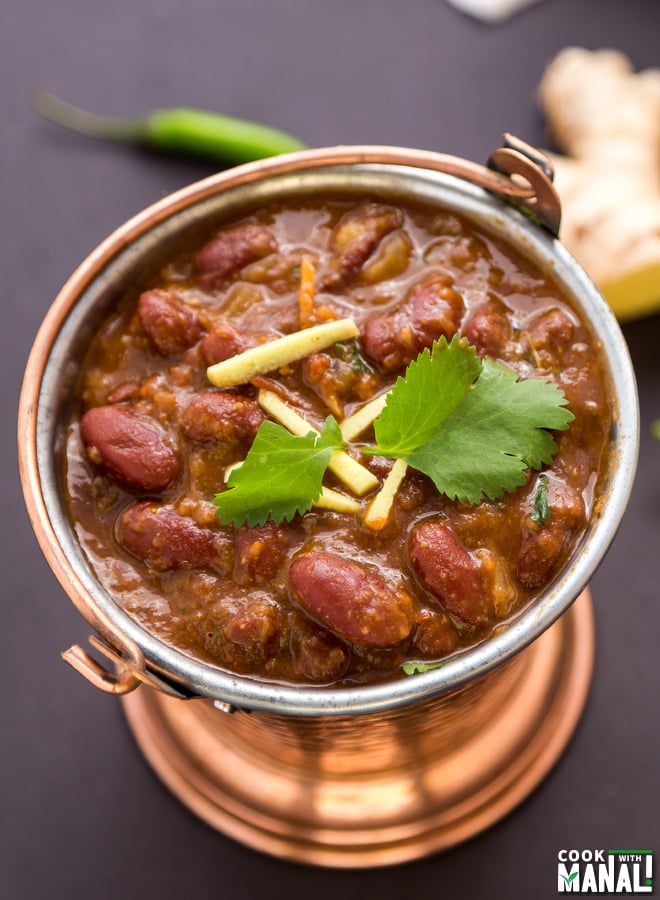
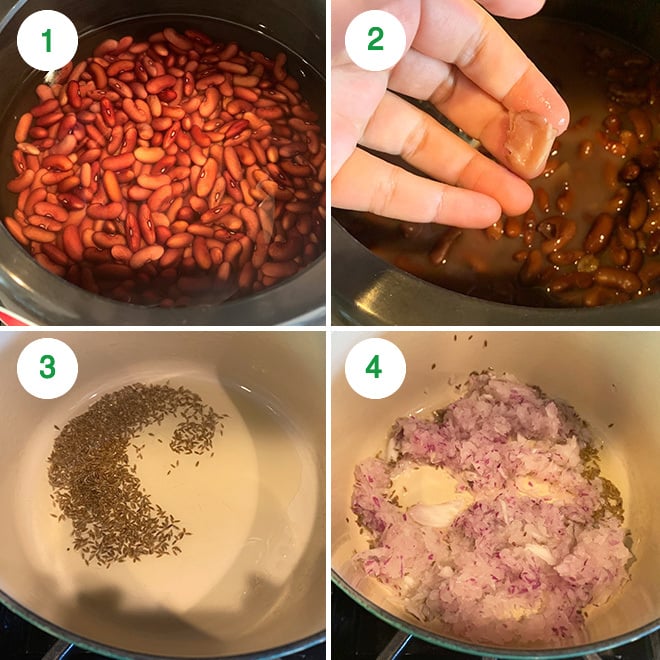
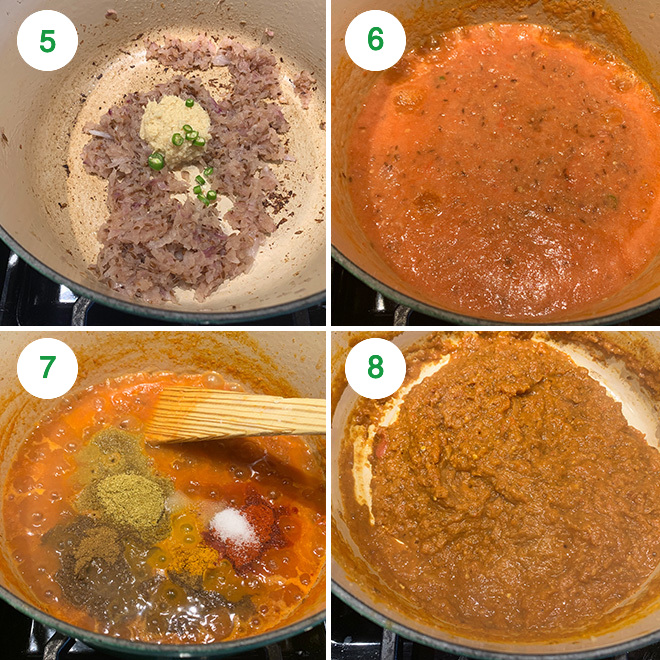
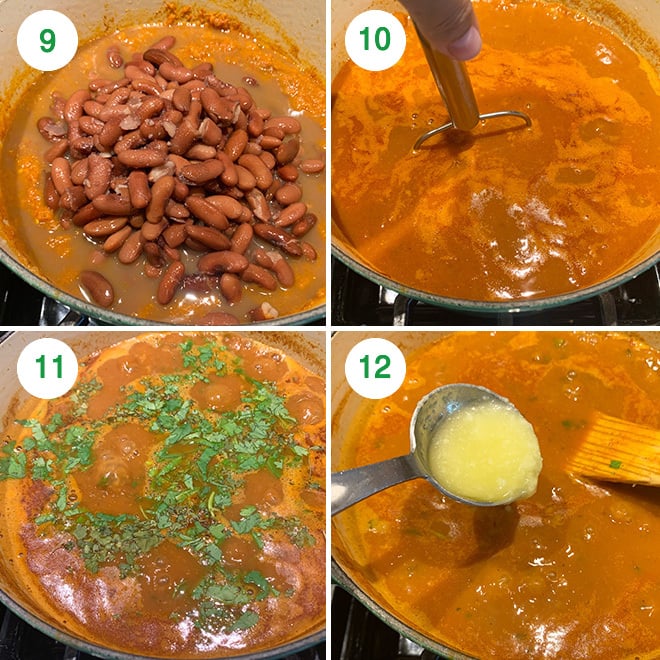
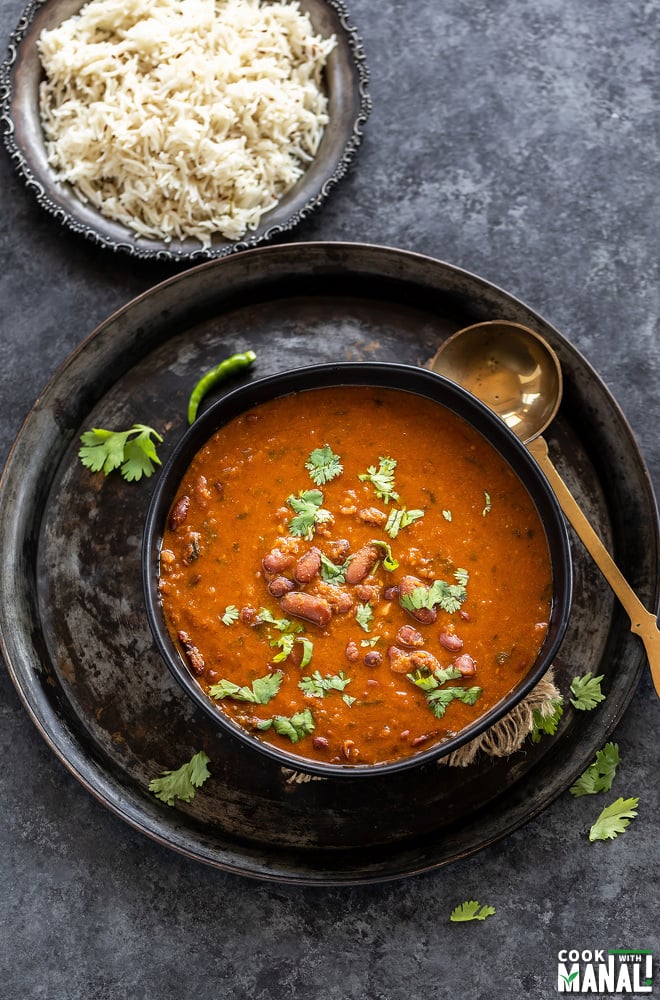
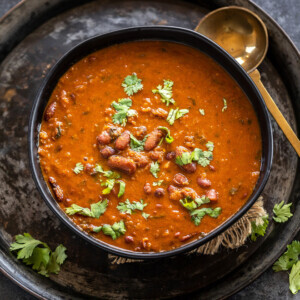
title: “Rajma Masala Kidney Beans Curry " ShowToc: true date: “2024-10-17” author: “Martha Harris”
Aug 19, 2020, Updated May 09, 2022 Kidney beans are cooked with onion, tomatoes and spices in this flavorful vegetarian curry.
Rajma is one of the most popular curries in north India. In fact I always say that chole, rajma and dal makhani are like the 3 most popular north Indian main course vegetarian recipes. Whenever we would invite someone over for lunch or dinner, mom would definitely make one of these. It was inevitable. However I was not very fond of rajma growing up, I don’t know why but I preferred it much less compared to the dals and chole and all my veggies. Sarvesh on the other hand is a huge rajma fan. It’s probably one of his favorite dishes (that’s a typical Punjabi right there)! But my taste buds have changed over the years and now I really enjoy rajma, especially the one I make. I do not like rajma if the curry is on the thinner side. For me a good rajma should be flavorful with the beans blending in with the spices and the curry should slightly be on the thicker side and have a melt-in-mouth texture.
What is Rajma
Rajma is kidney beans curry which is made by pressure cooking raw kidney beans which are soaked overnight. The pressure cooked beans are then cooked with onion, tomatoes, ginger-garlic and with spices like coriander, garam masala, chili powder etc. It’s an extremely popular curry in North India and a true Punjabi meal if often incomplete without it. Rajma is traditionally vegan (except when you add ghee to it) and also gluten-free. It is also a protein rich curry.
Which Kidney Beans To Use
Now when you go to market, you will see variety of kidney beans. There are lighter ones and also dark kidney beans. There are also varieties which are smaller in size. The smaller kidney beans are used in Kashmiri Rajma, which is a different recipe and uses different spices and you can find the recipe in my cookbook. You can use either one of the light or dark color large kidney beans to make punjabi style rajma. I prefer the darker ones.
Tips To Make a Good Rajma
So, I am going to share some of my tips that I have learned over the years to make a good rajma. Start with raw beans: yes you can make it with canned beans but a good rajma needs to be made with raw kidney beans. The beans need to be soaked overnight and then pressure cooked for that soft texture which is a must for rajma. I am sure most people who grew up around Delhi, would swear by the melt-in-mouth texture of rajma chawal (rajma and rice) being served at several food stalls across the city. And for that texture, you need to soak the beans, there are no two ways about it. Grate the onions or finely chop them: for that smooth curry, either grate the onions or really finely chop them. Also when you use grated onions, it takes a little longer for them to cook for the raw smell to go away, so have patience while cooking them. Use fresh ginger-garlic paste: again it will make a difference to the final taste of the rajma. Cook tomatoes for a longer time: do not rush this step. After you add the tomato puree, cook the tomatoes in total for around 15 minutes on medium heat before adding the kidney beans to the pan. I know that might seem like a long time but it’s important. Simmer on low heat: so after you add the boiled kidney beans to the pan, lower the heat and let the curry simmer for 20 minutes, at the very minimum. If you have time, add an additional 10 minutes. This simmering on low heat helps in developing the flavors and the curry tastes so much better. Mash some of the rajma to thicken the curry: while the rajma is simmering, take a spoon (or potato masher) and mash some of the kidney beans (not all) with the back of your spoon. This thickens the curry, gives it a texture and makes it creamier. Touch of ghee at end: I love adding a tablespoon of ghee at the end to my rajma. It really brings the flavors together. Sometimes, I would add fry some ginger julienne in the ghee and add to the rajma. Tastes even better the next day: curries like rajma and chole taste even better the next day. The beans absorb the flavors so well overnight and so the taste increases the next day.
Using Canned Beans
You can use canned beans here too. Use around 2.5 cans (around 3.5 to 4 cups of cooked beans) for this recipe. If using canned beans, skip the step of pressure cooking the beans. Start with making the masala, and then add the beans directly to the pan and then cook as mentioned in the recipe.
Serving Suggestions
In Delhi, rajma is always eaten with rice, popularly known as “rajma-chawal”. In fact if you ask people who are from Delhi (like my husband), half of them will say that rajma-chawal is their favorite dish. So obviously there cannot be a better combination than plain white rice. But you can also serve it with quinoa or brown rice. To make a complete meal with rajma, serve it with a side of aloo gobi or aloo palak.
Making it Vegan
This recipe is all vegan except for the ghee that I added at the end. Simply skip the ghee to keep this rajma recipe vegan. Older Recipe: I have updated this recipe to make it simpler. If you guys want to make it the same way as the older recipe shared on the blog, then along with the cumin seeds add a bay leaf, 2-3 green cardamom, 3 black cardamom and 1-inch cinnamon stick. Use 2 teaspoons rajma masala powder and cut down the coriander powder and garam masala to 1/2 teaspoon each. Rest of the recipe will remain same.
Method
1- Soak kidney beans overnight in 4 cups water. In the morning, drain the water in which the beans were soaked and then transfer them to a pressure cooker. Add 3.5 cups water, 1 teaspoon salt and pressure cook on high heat for 1 whistle, then lower the heat to medium and cook for 15 minutes. Let the pressure release naturally. If using an Instant Pot, pressure cook for around 45 minutes at high pressure with natural pressure release. 2- Beans should be completely soft when done. Set aside. 3- To a pan, add 2 tablespoons oil on medium heat. Once hot, add the cumin seeds and let them sizzle. 4- Then add the grated onions and mix.
5- Cook the onions for around 7 to 8 minutes, stirring often until very light golden in color and there should be no raw smell. Compared to chopped onions (if using chopped, cook for 3-4 minutes only) the grated ones needs to be cooked for a longer time to get rid of the raw smell. Don’t rush the step else curry will have raw onion taste. Then add ginger-garlic paste and green chili and cook for 1 minute. 6- Add the pureed tomatoes and mix. Cook for 5 minutes. 7- Then add the spices- coriander, turmeric, kashmiri red chili, garam masala and salt. 8- Mix and cook on medium-low heat for around 10 mins until oil oozes out of masala. In total we cooked the tomatoes for around 15 minutes before adding the beans (important step, don’t rush it).
9- Add the boiled beans along with all the water in which they were boiled. I added additional 1 cup water here. Stir well and set heat to low-medium. 10- Let the curry simmer for 20 to 30 minutes. In between use a potato masher to mash some of the beans. This makes the curry creamier and thickens it. 11- Then after it has simmered for 20 to 30 minutes, add kasuri methi and cilantro. If you want you can also add bit of cream (optional, I did not add). I also added another 1/2 cup water here as it became quite thick while simmering. You can adjust consistency to preference. 12- Finally add a tablespoon of ghee and mix. Turn off the heat. If you want you can fry some ginger julienne in ghee and then add that to the rajma too.
Serve rajma masala hot with rice!
If you’ve tried this Rajma Masala Recipe then don’t forget to rate the recipe! You can also follow me on Facebook and Instagram to see what’s latest in my kitchen! This post has been updated from the recipe archives, first published in October 2014.






